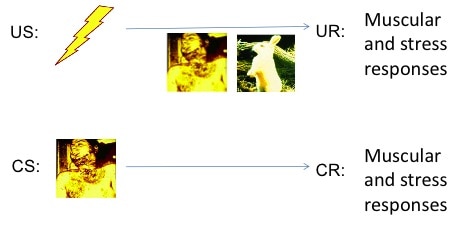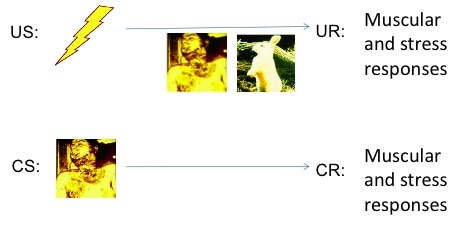In the previous blog Learning and chronic pain Part 1 we discussed a model for a way in which a neutral stimulus (conditioned stimulus or CS) when repeatedly paired with a biologically significant stimulus (the unconditioned stimulus or US) might come to elicit a conditioned response (or CR) that is similar to the response to the biologically significant stimulus (the unconditioned response or US). Well here is a bit more on it.
It is not new – in 1985 Flor and Turk subjected three groups of 17 subjects to four different stressful conditions including two personally relevant stressors (“describe a recent stressful event and a pain episode for one minute”), a general stressor (count backwards by sevens from 758 as quick as possible) and a neutral condition (recite alphabet for 1 min). They simultaneously measured the muscular responses for comparison among the three groups (chronic low back, general pain, and healthy controls).
The increase in muscle tone to the general stress and the neutral conditions were equal across groups. There was however, an abnormally large increase in the response of the paraspinal muscles to personally relevant stress, and only in the chronic back pain group. They concluded that the exclusivity of this response suggests it is a previously learnt response (classically conditioned).
In 2004 Flor and colleagues conducted an experiment to look closer at the process of acquiring conditioned muscular responses in a group of 11 chronic neck/upper back pain sufferers relative to 11 healthy controls.
Figure 1: During the conditioning process the subject watched a screen which displayed images at random (blood covered body or baby rabbit). 80% of the body images (CS) were followed by an electric shock (US) to the finger, in order to condition a biological response the previously (relatively) neutral stimulus.
All groups showed conditioning of muscular responses in the forearm and orbicularis muscle (associated with a startle response). The difference in the pain group was that they also generalised this muscular response to their upper trapezius muscle (a site relevant to their painful condition). This fits with Flor’s aforementioned study showing that stress and pain related muscular responses are specific to the reactive site, not the type or location of the threat, (provided it is personally relevant). Another finding was that during the extinction phase (where the CS is repeatedly presented without the electric shock [US]), the conditioned responses were maintained for longer and begun to generalise to the sight of the other image (baby rabbit).
In addition, the EEG findings at critical points of the conditioning process showed a reduction in brain activity at specific sites previously associated with aversive Pavlovian conditioning……..the authors hypothesised that this may reflect a more automised/rehearsed and therefore a more efficient conditioning response.
Flor and colleagues concluded that enhanced conditionability, the resistance to extinction and the tendency to generalize responses might all be mechanisms that contribute to chronic hyperreactivity of the muscular system in chronic pain patients. As discussed in our previous post this last sentence may also be true if we replaced the phrase “muscular system” with “pain system”. This is where I am going for my PhD so stay tuned…..
About Daniel Harvie
 Daniel is a recently commenced PhD candidate in the Body in Mind Research Group at UniSA. He has a clinical physiotherapy background and is a graduate of the Master of Musculoskeletal and Sports degree at the University of South Australia. His research will look at the application of learning models to the development and extinction of chronic pain.
Daniel is a recently commenced PhD candidate in the Body in Mind Research Group at UniSA. He has a clinical physiotherapy background and is a graduate of the Master of Musculoskeletal and Sports degree at the University of South Australia. His research will look at the application of learning models to the development and extinction of chronic pain.
He enjoys writing and recording music, hasn’t had a car for 3 months (an experiment) and has a bionic knee.
References
References
Flor, H. & Birbaumer, N. (1994). Acquisition of chronic pain*Psychophysiological mechanisms APS Journal, 3 (2), 119-127 DOI: 10.1016/S1058-9139(05)80339-0
Flor H, Turk DC, & Birbaumer N (1985). Assessment of stress-related psychophysiological reactions in chronic back pain patients. Journal of consulting and clinical psychology, 53 (3), 354-64 PMID: 3159767
Schneider C, Palomba D, & Flor H (2004). Pavlovian conditioning of muscular responses in chronic pain patients: central and peripheral correlates. Pain, 112 (3), 239-47 PMID: 15561378




